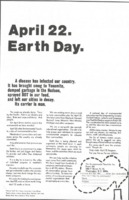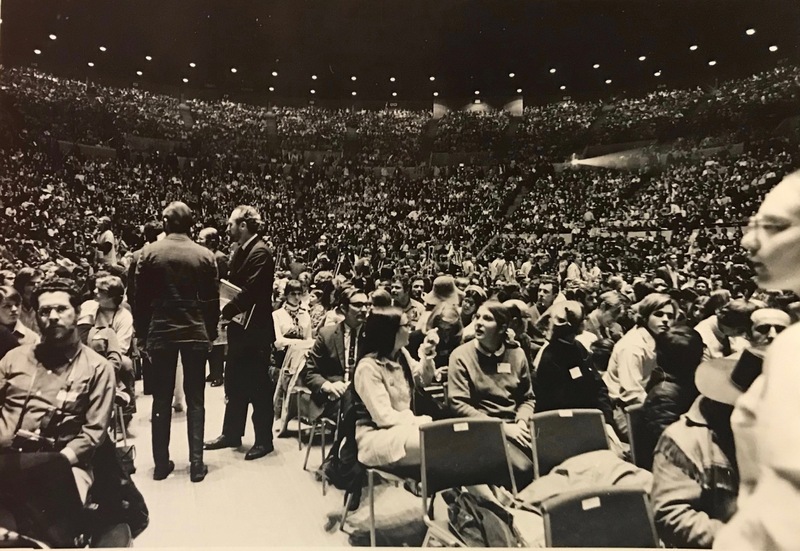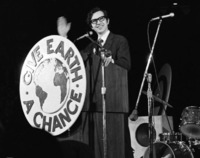II. ENACT Teach-In and Earth Day, Spring 1970
The fall of 1969 saw the advent of the environmental teach-in as a tool for social and political change. Concerned environmental groups were frustrated with government and corporate solutions to the crises that permeated the national consciousness. These environmental groups did not yet have the widespread support to affect change the way they wanted to, so in order for them to guarantee drastic social and policy change, they would have to undergo drastic measures to build support for their ideas. They saw the success that grassroots community activism had enjoyed in other areas of American politics like the anti-Vietnam War movement, and adopted some of their more successful strategies like the teach-in. These teach-ins would serve to educate the masses and build networks of support for the movement. With environmental crises happening around the country, and activism influencing society in new and profound ways, the time was right to scale up the environmental movement through the use of teach-ins.
In 1970, activists held environmental teach-ins across the country and employed many strategies pioneered by the anti-Vietnam War teach-ins of the 1960s. Barry Commoner, a prominent scientist who spoke at multiple environmental teach-ins, discussed the link between the University of Michigan’s Vietnam War Teach-In of 1965 and the Environmental Action for Survival (ENACT) Teach-In that took place on Michigan’s campus in March 1970. The “teach-in was born here at the University of Michigan,” and so it was fitting that U-M also became home to the first teach-in on the environment. Teach-ins were a popular and viable option to implement change and spread awareness quickly and effectively. Commoner stated in his interview that knowledge was power and could be transferred through teach-ins, making them an influential way of educating others. With this in mind, student activists and local groups planned environmental teach-ins at colleges and in communities around the country.
US Senator Gaylord Nelson, a Democrat from Wisconsin, spent much of the 1960s championing environmental causes and pushing for change, but he was mostly met with indifference from his fellow politicians. Environmentalism simply did not have the political capital necessary to qualify as a major issue. Nelson believed this to be a travesty of the highest order. Like his compatriots at U-M, he looked to the teach-in as a tool to manufacture that political capital. In the fall of 1969, Nelson announced that a National Teach-In on the Environment would be held on campuses across the country in the spring of 1970. He began a nationwide speaking tour giving talks on campuses to encourage local community leaders and activists to organize their own teach-ins on the environment, and he created Environmental Teach-In, Inc. to coordinate all of the different teach-ins. Environmental Teach-In soon decided to expand beyond just college campuses to high schools and cities as well. The main organizers also decided to change the name to something more universal and thus the National Teach-In on the Environment became Earth Day.
This wave of environmental energy swept through the University of Michigan’s campus and across the country in the fall of 1969. With nearly a decade of environmental movements coming to a head, students at Michigan realized the environment was an area of serious concern that needed to be addressed and discussed with the public. With motivation from Senator Gaylord Nelson who was encouraging colleges nationwide to educate as many people as possible, students at U-M formed ENACT:
“To deal effectively with these challenging issues--and in time--will require unprecedented commitment. Environmental Action for Survival, ENACT, has been formed at the University of Michigan by a trans-disciplinary group of students, faculty, and community leaders. We are united as environmentalists, concerned will all facets of human survival on a fragile planet. Meeting this challenge requires immediate and direct action.”
The months that followed ENACT's formation would be filled with event planning, community outreach, and fundraising for their Environmental Teach-In in March of 1970. The Teach-In educated thousands of people on environmental issues of the time and left a lasting impact on the Ann Arbor community. The first Environmental Teach-In took place on the University of Michigan campus, but it did not end there. Senator Gaylord Nelson’s call to action in the fall of 1969 led to the first Earth Day and a new generation of politically engaged environmental activists.
The idea for the Environmental Teach-In was not singularly Nelson’s or ENACT's, but rather arose from a similar desire and drive to protect the environment that was emerging throughout the country due to years of environmental crises created by man. In the words of Doug Scott, a co-chair of ENACT, “we were in the forefront of something very big that went on in the country, and it wasn't that Doug Scott or Gaylord Nelson came up with some grand plan and pulled it over. There was something going on in the drinking water or in the air, in the whole country, that mushroomed in the fall of '69 into the Earth Day movement.”
Sources:
Interview with Doug Scott, 2013, Sierra Club Oral History Series, Regional Oral History Office, The Bancroft Library, University of California, Berkeley, htt://bancroft.berkeley.edu/ROHO/collections/subjectarea/natres/sierraclub.html
Barry Commoner Interview in University of Michigan Television Center, “Enact: Teach-In on the Environment,” 1970, Box 8, Media Resources Center (University of Michigan) Records, 1948-1987, Bentley Historical Library, University of Michigan
News and Information Services (University of Michigan) Photographs: 1946-2006, Bentley Historical Library, University of Michigan
ENACT, “Prospectus for the Teach-In on the Environment,” March 11-14, 1970, Environment: ENACT Conference 1970, Vertical File, Bentley Historical Library, University of Michigan




